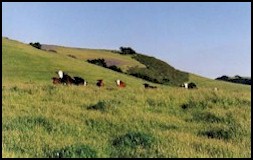

History
The early history of Two Hills is best described by the Cree word "Matapeskuteweyak", which means "the prairie that comes out of the river". The river referred to is the North Saskatchewan that borders most of the counties north side. The County of Two Hills was the area where the prairie met the Boreal/Coniferous forest and was host to several different Aboriginal groups that thrived in its diversity.
The first white man to come to the area would have passed through on the North Saskatchewan River before the turn of the century and was mainly here to explore the area and find a passage through to the Pacific Ocean. As time wore on fur traders and explorers co-inhabited the area with the Native Americans, trading furs and supplies, using the North Saskatchewan as a shipping route. Some time in the late 1880's the area was surveyed and was open for homesteading. It wasn't until 1894 when Tomas Watt filed the first home stead claim ten miles west of present day Two Hills, that the area became a farming and ranching hub. For almost a decade the Two Hills District was mainly populated by English speaking settlers, who were horse breeders and cattle men. Ukrainian settlers did not arrive in the area until the early 1900s when an influx of thousands of Central Europeans developed most of the area and made it their home.
The early government of the area was still part of the Northwest Territories and was legislated through the Statue Labour Ordinance until 1897 when the Local Improvement Ordinance was introduced, allowing taxes to be collected for the first time. After Alberta became a Province in 1905 the Two Hills area along with much of the surrounding region was officially recognized as three separate improvement districts with one elected official each. From then on several different successive branches and divisions of government ran the area dealing with issue's that included health, infrastructure and hamlet development.
The Pacific Railway was built through the Two Hills county in 1927. The town of Two Hills became the most important trading center on the railway line between Edmonton and Lloydminster. After the railway was completed in 1929, many stores started to open up in the town. Two Hills became a village on July 3, 1929 with a population of 103. It became a town in 1955 and is where the present day county office sits.